Confederate States dollar
| Confederate States dollar | |
|---|---|
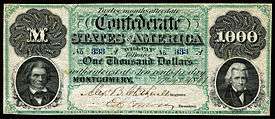  $50 depicting Jefferson Davis | |
| User(s) |
|
| Subunit | |
| 1/100 | cent |
| Symbol | $ or C$ |
| cent | ¢ |
| Coins | Confederate Half Dollar |
| Banknotes | 50¢, $1, $2, $5, $10, $20, $50, $100, $500, $1000 |
|
This infobox shows the latest status before this currency was rendered obsolete. | |
The Confederate States of America dollar was first issued just before the outbreak of the American Civil War by the newly formed Confederacy. It was not backed by hard assets, but simply by a promise to pay the bearer after the war, on the prospect of Southern victory and independence.
As the war began to tilt against the Confederates, confidence in the currency diminished, and inflation followed. By the end of 1863, the Confederate dollar (or "Greyback", to distinguish it from the then-new "Greenback" paper US dollar, which was likewise put into circulation during the war) was quoted at just 6 cents in gold, and fell further still.
The Greyback is now a prized collector's item, in its many versions, including those issued by individual states and local banks. The various engravings of leading Confederates, gods and goddesses and scenes of slave-life, on these hastily printed banknotes, sometimes cut with scissors and signed by clerks, continue to stimulate debate among antique dealers, with even some of the counterfeit notes commanding high prices.
Background
The Confederate dollar, often called a "Greyback", was first issued into circulation in April 1861, when the Confederacy was only two months old, and on the eve of the outbreak of the Civil War.
At first, Confederate currency was accepted throughout the South as a medium of exchange with high purchasing power. As the war progressed, however, confidence in the ultimate success waned, the amount of paper money increased, and their dates of redemption were extended further into the future. Most Confederate currency carried the phrase across the top of the bill: "SIX MONTHS AFTER THE RATIFICATION OF A TREATY OF PEACE BETWEEN THE CONFEDERATE STATES AND THE UNITED STATES" then across the middle, the "CONFEDERATE STATES OF AMERICA WILL PAY [amount of bill] TO BEARER" (or "...WILL PAY TO BEARER [amount of bill]" or "...WILL PAY TO BEARER ON DEMAND [amount of bill]").
As the war progressed, the currency underwent the depreciation and soaring prices characteristic of inflation. For example, by the end of the war, a cake of soap could sell for as much as $50 and an ordinary suit of clothes was $2,700.
Near the end of the war, the currency became practically worthless as a medium of exchange. This was because Confederate currency were bills of credit, as in the Revolutionary War, not secured or backed by any assets. Just as the currency issued by the Continental Congress was deemed worthless (witness the phrase "not worth a Continental;" and see The Federalist Papers, which also addressed this issue in the run-up to the ratification of the U.S. Constitution) because they were not backed by any hard assets, so, too, this became the case with Confederate currency. Even though both gold and silver may have been scarce, some economic historians have suggested that the currency would have retained a relatively material degree of value, and for a longer period of time, had it been backed by hard goods the Confederacy did have, perhaps such as cotton, or tobacco. When the Confederacy ceased to exist as a political entity at the end of the war, the money lost all value as fiat currency.
Designs
The South, being limited in skilled engravers and printers as well as secure printing facilities, often had to make do with unrelated designs in early banknote issues. Some such were abstract depictions of mythological gods and goddesses, such as the Goddess of Liberty. Southern themes did prevail with designs of black slaves, naval ships and historical figures, including George Washington. Images of slaves often had them depicted as smiling or happily carrying about their work.
Since most of the engravers and bank plates were in the North, Southern printers had to lift by offset or lithographic process scenes that had been used on whatever notes they had access to. Many variations in plates, printing and papers also appear in most of the issues, due in large part to the limits on commerce resulting from the Union embargo of Confederate ports.

Some of the people featured on banknotes include Andrew Jackson, John C. Calhoun, Christopher Memminger, Robert M. T. Hunter, Alexander H. Stephens, Jefferson Davis, Judah P. Benjamin, Clement Clay, George W. Randolph, and Lucy Holcombe Pickens, the wife of the Governor of South Carolina.[1][2][3][4][5] There was also a bill featuring George Washington.[6]
Signatures
Confederate Treasury Notes were hand signed by various clerks, with exception of the 50 cent issues that had the printed signatures of Robert Tyler and Edward C. Elmore. The first six notes issued were hand signed by the Register and Treasurer themselves. While hand signatures were considered an anti-counterfeiting tool, the sheer number of bills being produced could not reasonably be signed individually by two men each. Women were often hired as clerks to sign "for Register" and "for Treasurer"; up to 200 clerks were eventually hired for each.
Coinage

As the Civil War continued, the cost of the war loomed large. Any precious metals available in the South often made their way to Europe to procure war goods. But the CSA did manage to mint a few coins. In 1861, Mr. Robert Lovett Jr. of Philadelphia was commissioned to design, engrave and make a one cent piece for the Confederacy. On the obverse (front), he used the head of Minerva (French Liberty Head), which he had used on several store cards. The coins were struck using the then Federal standard of cupronickel for cent pieces. He made a few samples, of which only 12 are said to exist by the popular stories but research has shown that 14 are currently known to exist. Fearing prosecution for aiding the enemy, he stopped his work and hid the coins and dies in his cellar. The original dies were purchased later and used to make restrikes, first by John W. Haseltine and later by Robert S. Bashlow. The dies were donated to the Smithsonian Institution by Bashlow in 1962.
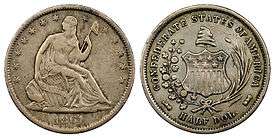
In late April 1861, four Confederate half dollars were struck on a hand press by certain employees of the New Orleans Mint. Because of the high relief of the coin die, a test striking was made to see if coins would release from the Confederate die. The die was made by a printing plate engraver (A.H.M. Peterson) in New Orleans who was unfamiliar with techniques required to engrave coining dies. These coins were struck using a U.S. obverse die (Seated Liberty) and the Confederate die made by Peterson. These coins are known as originals, and the location of all four of the coins is known today.
As the result of an 1879 article about the Confederate cent printed in a New York City newspaper, Benjamin F. Taylor, M.D. (Chief Coiner, New Orleans Mint, CSA) contacted coin dealer Ebenezer Mason. Taylor informed Mason of the existence of the Confederate half dollar and the die. Mason bought the die and coin from Taylor and sold them to J.W. Scott Co. of New York City, a coin and stamp dealer. Scott bought 500 1861 United States half dollars from a New York bank that were supposedly struck at the New Orleans Mint. Scott had the reverse of the half dollars planed down and performed a one-sided strike using the Confederate half dollar die. The Seated Liberty obverse of the coins were flattened some because of the one-sided strike. In addition, Scott struck 500 half dollar sized tokens in white metal using the Confederate die and a newly made die to commemorate the restrikes of the Confederate half dollars. The Confederate half dollar die went missing during the 1920s and has not been seen since.
Popular stories claim one of the Confederate half dollars was given to Confederate President Jefferson Davis. This story has no basis in fact. In an 1879 letter to Ebenezer Mason, Davis confirmed that a Union soldier (actually a Federal Officer) stole a coin from one of his wife’s trunks, but could not confirm that it was like the then known Confederate half dollar. It is very possible that the coin was a gold so-called Jefferson Davis dime struck at the Paris (France) Mint, which Davis described to coin dealer Ed Frossard in an 1880 letter. All known Jefferson Davis dimes were struck in silver at the Paris Mint. The Davis letter is the only known reference to a gold specimen, which was likely a special presentation piece made for Davis.
Banknotes
Confederate Treasury Notes (banknotes) were ultimately issued in 50-cent, $1, $2, $5, $10, $20, $50, $100, $500 and $1,000 denominations with a variety of designs, issuers and redeemable obligations. The amount of currency issued under the various acts of the Confederate Congress totaled $1.7 billion. Bills were released in 72 different note "types" in seven "series" from 1861 through 1864.
Since there were many types of Confederate notes as well as notes issued by the states of the Confederacy, and since banks could issue their own notes, counterfeiting was a major problem for the Confederacy. Many of these contemporary counterfeits are identifiable today and they can be as valuable to a collector as a real note.[7]
Confederate dollars and coins are regarded as a cherished part of American history, and remain the subject of a lively trade, with careful grading of damage and deterioration similar to booksellers' gradings.
Series of CSA notes
| Series | Authorization | Amount | Denominations | Comments |
|---|---|---|---|---|
| First[8] | Act of March 9, 1861 Amended August 3, 1861 |
$1,000,000 (i) $1,000,000 (ii) |
$50, $100, $500, $1000 (i) $50, $100 (ii) |
Interest bearing at 3.65% |
| Second[9] | Act of May 16, 1861 | $20,000,000 | $5, $10, $20, $50, $100 | No interest, payable two years after peace was established between the CSA and U.S. |
| Third[10] | Act of August 19, 1861 Amended December 24, 1861 |
$100,000,000 (i) $50,000,000 (ii) |
$5, $10, $20, $50, $100 | Funded by 8% bonds, payable six months after a treaty/peace between the U.S. and CSA |
| Fourth[11] | Act of April 17, 1862 Amended September 23, 1862 |
$170,000,000 (i) $5,000,000 (ii) |
$1, $2, $10, $20, $100 | Introduced $1 and $2 notes, and $100 interest-bearing notes (2 cents per day) |
| Fifth[12] | Act of October 13, 1862 | $90,000,000[n 1] | $1, $2, $5, $10, $20, $50, $100 | Payable six months after ratification of a treaty. Lower denominations issued on pink paper. |
| Sixth[14] | Act of March 23, 1863 | $50,000,000[n 2] | $0.50, $1, $2, $5, $10, $20, $50, $100 | Payable two years after ratification of a treaty. |
| Seventh[16] | Act of February 17, 1864 | $200,000,000[n 3] | $0.50, $1, $2, $5, $10, $20, $50, $100, $500 | Payable two years after ratification of a treaty. |
Printers and engravers of Confederate States dollar banknotes (1861–1864)
| Engraver/Printer | Location | Types printed | Comments |
|---|---|---|---|
| National Bank Note Company | New York, NY | 1–4 | Part of the American Bank Note Company |
| Southern Bank Note Company | New Orleans, LA | 5, 6, 15, 19, 22, 31 | Southern branch of the American Bank Note Company.[18] |
| Hoyer & Ludwig | Richmond, VA | 7–11, 13–14, 17–18, 27–28, 35–36, 46 | Louis Hoyer and Charles Ludwig, in operation 1861–64.[19] |
| Jules Manouvrier | New Orleans, LA | 12 | Lithographer, contracted to print $10 CSA notes. Some were stolen and entered circulation with forged signatures. Contract cancelled.[20] |
| Leggett, Keatinge & Ball | Richmond, VA | 23, 24, 32, 33 | Edward Keatinge (formerly a portrait engraver with the Southern Bank Note Company) joined Leggett & Ball shortly after the Civil War began. Leggett was forced out after being accused of spying for the Union, and the company became Keatinge & Ball.[21] |
| Keatinge & Ball | Columbia, SC Richmond, VA |
16, 21, 25, 26, 34, 41, 49–62, 64–71 | In 1862, Keatinge & Ball moved to Richmond.[21] |
| Blanton Duncan | Columbia, SC Richmond, VA |
20, 29, 30, 37, 38, 42–45 | Originally from Kentucky, Duncan moved to Richmond at the invitation of Christopher Memminger to open a paper mill and printing plant.[22] |
| J.T. Patterson | Columbia, SC | 28, 36, 39, 40, | |
| Archer & Daly | Richmond, VA | 63 | A lithographic firm specializing mainly in CSA stocks and bonds.[23] |
| Archer & Halpin | Richmond, VA | 72 |
Complete typeset of CSA banknotes
| Series/Date | Type[n 4] | Value | Image | Comments[n 5] |
|---|---|---|---|---|
| |
T–1 5 Apr 1861 21 Jun 1861 |
$1,000 |  |
John C. Calhoun, Andrew Jackson National Bank Note Company (607 issued)[26] |
| T–2 8 Apr 1861 23 Jul 1861 |
$500 |  |
Ceres,The Crossing (by James Smillie) National Bank Note Company (607 issued)[27] | |
| T–3 5 Apr 1861 21 Jun 1861 |
$100 |  |
Minerva, railroad National Bank Note Company (1,606 issued)[28] | |
| T–4 5 Apr 1861 21 Jun 1861 |
$50 | 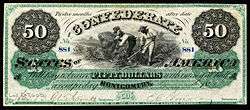 |
Slaves working in the field National Bank Note Company (1,606 issued)[29] | |
| T–5 25 Aug 1861 23 Sep 1861 |
$100 |  |
Justice, Hudson River Railroad, Minerva Southern Bank Note Company (5,798 issued)[30] | |
| T–6 25 Aug 1861 23 Sep 1861 |
$50 |  |
Justice, Agriculture and Industry, George Washington Southern Bank Note Company (5,798 issued)[31] | |
| |
T–7 29 Jul 1861 22 Oct 1861 |
$100 |  |
George Washington, Ceres and Prosperina Hoyer & Ludwig (Richmond, VA) (37,155 issued)[32][n 6] |
| T–8 29 Jul 1861 22 Oct 1861 |
$50 |  |
Tellus, George Washington Hoyer & Ludwig (Richmond, VA) (123,564 issued)[34] | |
| T–9 25 Jul 1861 26 Oct 1861 |
$20 |  |
Sailing ship Hoyer & Ludwig (Richmond, VA) (264,988 issued)[35] | |
| T–10 25 Jul 1861 2 Nov 1861 |
$10 |  |
Liberty (seated), Liberty (leaning on shield) Hoyer & Ludwig (Richmond, VA) (170,994 issued)[36] | |
| T–11 29 Jul 1861 7 Sep 1861 |
$5 |  |
Sailor (leaning), Liberty (seated) Hoyer & Ludwig (Richmond, VA) (73,355 issued)[37] | |
| T–12 | $5 |  |
"Confederate States of America" Jules Manouvrier (New Orleans, LA) (15,556 issued)[38] | |
| |
T–13 22 Oct 1861 16 Apr 1862 |
$100 |  |
Sailor (standing), slaves loading cotton Hoyer & Ludwig (Richmond, VA) (629,284 issued)[39] |
| T–14 22 Oct 1861 16 Apr 1862 |
$50 |  |
Sailors, Moneta with treasure chest Hoyer & Ludwig (Richmond, VA) (469,660 issued)[40] | |
| T–15 8 Jan 1862 15 May 1862 |
$50 |  |
Hope, Hudson River Railroad, Justice Southern Bank Note Company (14,860 issued)[41] | |
| T–16 17 Apr 1862 10 Dec 1862 |
$50 |  |
Jefferson Davis Keatinge & Ball (Richmond, VA) (425,944 issued)[42] | |
| T–17 14 Sep 1861 5 Nov 1861 |
$20 |  |
Liberty, Ceres between Commerce and Navigation Hoyer & Ludwig (Richmond, VA) (43,732 issued) [43] | |
| T–18 24 Oct 1861 16 Aug 1862 |
$20 |  |
Sailor, Sailing ship Hoyer & Ludwig (Richmond, VA) (2,366,486 issued)[44] | |
| T–19 8 Jan 1862 15 May 1862 |
$20 |  |
Minerva, Navigation, Blacksmith Southern Bank Note Company (14,860 issued)[45] | |
| T–20 21 Jun 1862 8 Dec 1862 |
$20 |  |
Alexander H. Stephens, Industry between Commerce and beehive B. Duncan (Columbia, S.C.) (2,834,251 issued)[46] | |
| T–21 28 Jun 1862 15 Nov 1862 |
$20 |  |
Alexander H. Stephens Keatinge & Ball (Columbia, S.C.) (164,248 issued)[47] | |
| T–22 13 Nov 1861 15 May 1862 |
$10 |  |
Thetis, Native-Americans, Female with X Southern Bank Note Company (58,860 issued)[48] | |
| T–23 15 Nov 1861 30 Dec 1861 |
$10 |  |
John E. Ward, Wagon of cotton, Corn gatherer Leggett, Keatinge & Ball (Richmond, VA) (20,333 issued)[49] | |
| T–24 20 Feb 1862 8 Dec 1862 |
$10 |  |
Robert M.T. Hunter (left); Alfred L. Elwin (vignette, as child) Leggett, Keatinge & Ball (Richmond, VA) (278,400 issued)[50] | |
| T–25 12 May 1862 9 Aug 1862 |
$10 |  |
Robert M.T. Hunter (left); Hope; C.G. Memminger Keatinge & Ball (Richmond, VA) (178,716 issued)[51] | |
| T–26 12 Jul 1862 8 Dec 1862 |
$10 |  |
Robert M.T. Hunter (left); Hope; C.G. Memminger Keatinge & Ball (Richmond, VA) (514,400 issued)[52] | |
| T–27 26 Nov 1861 5 Dec 1861 |
$10 |  |
Liberty; Train Hoyer & Ludwig (Richmond, VA) (8,576 issued)[53] | |
| T–28 23 Jan 1862 13 Dec 1862 |
$10 |  |
Ceres and Commerce; Train Hoyer & Ludwig (Richmond, VA) J.T. Patterson (Columbia, S.C.) (1,074,980 issued)[54] | |
| T–29 17 Mar 1862 13 Sep 1862 |
$10 |  |
Slave picking cotton; canal B. Duncan (Richmond, VA) (286,627 issued)[55] | |
| T–30 14 Jun 1862 3 Jan 1863 |
$10 |  |
Robert M.T. Hunter (left); General Francis Marion’s Sweet Potato Dinner; Minerva B. Duncan (Columbia, S.C.) (1,939,810 issued)[56] | |
| T–31 13 Nov 1861 15 May 1862 |
$5 |  |
Navigation; Commerce, Agriculture, Justice, Liberty, and Industry; George Washington statue Southern Bank Note Company (58,860 issued)[57] | |
| T–32 15 Nov 1861 30 Dec 1861 |
$5 |  |
Boy; Machinist with hammer Leggett, Keatinge & Ball (Richmond, VA) (20,333 issued)[58] | |
| T–33 13 Mar 1862 19 Jun 1862 |
$5 |  |
C.G. Memminger; Minerva Leggett, Keatinge & Ball (Richmond, VA) (136,736 issued)[59] | |
| T–34 12 May 1862 8 Dec 1862 |
$5 |  |
C.G. Memminger; Minerva Keatinge & Ball (Richmond, VA) (228,644 issued)[60] | |
| T–35 26 Nov 1861 5 Dec 1861 |
$5 |  |
Slaves load cotton; Indian princess Hoyer & Ludwig (Richmond, VA) (7,160 issued)[61] | |
| T–36 31 Mar 1862 3 Jan 1863 |
$5 |  |
Sailor; Commerce (seated) Hoyer & Ludwig (Richmond, VA) J.T. Patterson (Columbia, S.C.) (3,694,890 issued)[62] | |
| T–37 7 Apr 1862 13 Sep 1862 |
$5 | 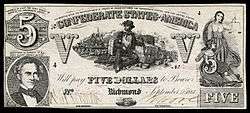 |
C.G. Memminger; Sailor (seated); Justice and Ceres B. Duncan (Richmond, VA) (1,002,478 issued)[63] | |
| |
T–38 | $2 | .jpg) |
Judah P. Benjamin; The South striking down the Union B. Duncan (Columbia, S.C.) (~36,000 issued)[64] |
| T–39 | $100 |  |
Milkmaid; train with straight steam Hoyer & Ludwig (Richmond, VA) J.T. Patterson (Columbia, S.C.) (284,000 issued)[65] | |
| T–40 | $100 |  |
Milkmaid; train with diffused steam J.T. Patterson & Co. (Columbia, S.C.) (214,400 issued)[66] | |
| T–41 | $100 |  |
John C. Calhoun; Slaves working; Confederacy Keatinge & Ball (Richmond, VA) (670,400 issued)[67] | |
| T–42 | $2 |  |
Judah P. Benjamin; The South striking down the Union B. Duncan (Columbia, S.C.) (1,520,000 issued)[68] | |
| T–43 | $2 |  |
Judah P. Benjamin; The South striking down the Union B. Duncan (Columbia, S.C.) (194,900 issued)[69] | |
| T–44 | $1 |  |
Liberty; Steamship at sea; Lucy Pickens B. Duncan (Columbia, S.C.) (1,689,860 issued)[70] | |
| T–45 | $1 |  |
Liberty; Steamship at sea; Lucy Pickens B. Duncan (Columbia, S.C.) (412,500 issued)[71] | |
| T–46 | $10 | .jpg) |
Ceres; Robert M.T. Hunter Hoyer & Ludwig (Richmond, VA) (635,250 issued)[72] | |
| T–47 | $20 |  |
Ceres; Robert M.T. Hunter Test pattern or fantasy note[73] | |
| T–48 | $10 |  |
Ceres; Robert M.T. Hunter Test pattern or fantasy note[74] | |
| |
T–49 | $100 |  |
Soldiers; Lucy Pickens; George W. Randolph Keatinge & Ball (Richmond, VA) (628,640 issued)[75] |
| T–50 | $50 |  |
Jefferson Davis Keatinge & Ball (Richmond, VA & Columbia, S.C.) (414,200 issued)[76] | |
| T–51 | $20 |  |
Tennessee State Capitol; Alexander H. Stephens Keatinge & Ball (Columbia, S.C.) (776,800 issued)[77] | |
| T–52 | $10 |  |
Proposed state capitol (Columbia, S.C.); Robert M.T. Hunter Keatinge & Ball (Columbia, S.C.) (3,060,000 issued)[78] | |
| T–53 | $5 |  |
Virginia State Capitol; C.G. Memminger Keatinge & Ball (Columbia, S.C.) (2,833,600 issued)[79] | |
| T–54 | $2 |  |
Judah P. Benjamin Keatinge & Ball (Columbia, S.C.) (607,000 issued)[80] | |
| T–55 | $1 |  |
Clement Claiborne Clay Keatinge & Ball (Columbia, S.C.) (1,141,200 issued)[81] | |
| |
T–56 | $100 | .jpg) |
Soldiers; Lucy Pickens; George W. Randolph Keatinge & Ball (Columbia, S.C.) (1,950,400)[82] |
| T–57 | $50 |  |
Jefferson Davis Keatinge & Ball (Richmond, VA and Columbia, S.C.) (2,349,600 issued)[83] | |
| T–58 | $20 |  |
Tennessee State Capitol; Alexander H. Stephens Keatinge & Ball (Columbia, S.C.) (4,429,600 issued)[84] | |
| T–59 | $10 |  |
Proposed state capitol (Columbia, S.C.); Robert M.T. Hunter Keatinge & Ball (Columbia, S.C.) (7,420,800 issued)[85] | |
| T–60 | $5 |  |
Virginia State Capitol; C.G. Memminger Keatinge & Ball (Columbia, S.C.) (7,745,600 issued)[86] | |
| T–61 | $2 |  |
Judah P. Benjamin Keatinge & Ball (Columbia, S.C.) (689,200 issued)[87] | |
| T–62 | $1 | 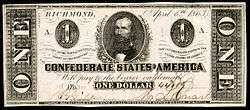 |
Clement Claiborne Clay Keatinge & Ball (Columbia, S.C.) (1,645,600 issued)[88] | |
| T–63 | $0.50 |  |
Jefferson Davis Archer & Daly (Richmond, VA) (1,831,517 issued)[89] | |
| |
T–64 | $500 |  |
Confederate seal and battle flag; Stonewall Jackson Keatinge & Ball (Columbia, S.C.) (~154,000 issued)[90] |
| T–65 | $100 |  |
Soldiers; Lucy Pickens; George W. Randolph Keatinge & Ball (Columbia, S.C.) (~964,000 issued)[91] | |
| T–66 | $50 |  |
Jefferson Davis Keatinge & Ball (Columbia, S.C.) (1,671,444 issued)[92] | |
| T–67 | $20 |  |
Tennessee State Capitol; Alexander H. Stephens Keatinge & Ball (Columbia, S.C.) (~4,150,000 issued)[93] | |
| T–68 | $10 |  |
Horses pulling cannon; Robert M.T. Hunter Keatinge & Ball (Columbia, S.C.) (~9,071,000 issued)[94] | |
| T–69 | $5 | 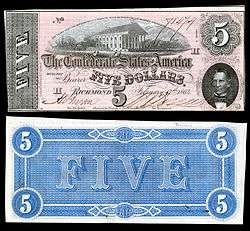 |
Virginia State Capitol; C.G. Memminger Keatinge & Ball (Columbia, S.C.) (~5,526,100 issued)[95] | |
| T–70 | $2 |  |
Judah P. Benjamin Keatinge & Ball (Columbia, S.C.) (~944,000 issued)[96] | |
| T–71 | $1 |  |
Clement Claiborne Clay Keatinge & Ball (Columbia, S.C.) (~681,500 issued)[97] | |
| T–72 | $0.50 |  |
Jefferson Davis Archer & Halpin (Richmond, VA) (~1,100,000 issued)[98] |
See also
- Economy of the Confederate States of America
- Fourteenth Amendment to the United States Constitution, which banned the Federal recognition of Confederate debts or currency.
- Texas dollar
- United States currency
- Samuel C. Upham, a notorious counterfeiter of Confederate bills.
Notes
- ↑ Despite the authorized amount, $138,000,000 was issued.[13]
- ↑ Despite the authorized amount, over $517,900,000 was issued.[15]
- ↑ Despite the authorized amount, over $400,000,000 was issued.[17]
- ↑ "T" numbers refer to the categorization system widely used in Confederate banknotes and denote major design changes.[24] Dates underneath "T" numbers (when available) indicate the beginning and end dates of issue for the particular note[25]
- ↑ Comments include the portraits or vignettes listed from left to right, the engraver and/or publisher of the note, and the number of notes issued. The single reference citation applies to all information in the cell.
- ↑ Federal authorities forbid the National Bank Note Company (and their affiliate Southern Bank Note Company) from printing currency for the Confederate States of America. The CSA turned to local lithographer Hoyer & Ludwig to print the next series of notes. The paper quality and printing technique is noticeably inferior to the prior First Series.[33]
References
- ↑ "$1,000 1861 Confederate States of America Note". Pmgnotes.com. Retrieved January 20, 2012.
- ↑ "Virtual Gettysburg-Featured Confederate Currency-Criswell Type 45". Virtualgettysburg.com. Retrieved January 20, 2012.
- ↑ "NMAH | Legendary Coins & Currency: Confederacy, 5 Dollars, 1862". Americanhistory.si.edu. October 24, 2008. Retrieved January 20, 2012.
- ↑ "NMAH | Legendary Coins & Currency: Confederacy, 10 Dollars, 1863". Americanhistory.si.edu. October 24, 2008. Retrieved January 20, 2012.
- ↑ "Confederate Currency". Rebelstatescurrency.com. Retrieved January 20, 2012.
- ↑ "Type 8 confederate money 50.00 George Washington scarce Choice Unc". Deerrunmercantile.com. Retrieved January 20, 2012.
- ↑ Rothman, Jordan. "A Pledge of a Nation: Charting the Economic Aspirations, Political Motivations and Consequences of Confederate Currency Creation" (PDF). Bir.brandeis.edu. Retrieved November 19, 2012.
- ↑ Fricke 2014, p. 121.
- ↑ Fricke 2014, p. 135.
- ↑ Fricke 2014, p. 167.
- ↑ Fricke 2014, p. 289.
- ↑ Fricke 2014, p. 353.
- ↑ Fricke 2014, p. 353.
- ↑ Fricke 2014, p. 397.
- ↑ Fricke 2014, p. 397.
- ↑ Fricke 2014, p. 469.
- ↑ Fricke 2014, p. 469.
- ↑ Hessler 1993, p. 296.
- ↑ Hessler 1993, p. 175.
- ↑ Hessler 1993, p. 212.
- 1 2 Hessler 1993, p. 187.
- ↑ Hessler 1993, p. 107.
- ↑ Hessler 1993, p. 34.
- ↑ Friedberg & Friedberg 2013, p. 250.
- ↑ Fricke 2014.
- ↑ Fricke 2014, p. 122.
- ↑ Fricke 2014, p. 124.
- ↑ Fricke 2014, p. 127.
- ↑ Fricke 2014, p. 129.
- ↑ Fricke 2014, p. 131.
- ↑ Fricke 2014, p. 133.
- ↑ Fricke 2014, p. 137.
- ↑ Fricke 2014, p. 135.
- ↑ Fricke 2014, p. 141.
- ↑ Fricke 2014, p. 145.
- ↑ Fricke 2014, p. 150.
- ↑ Fricke 2014, p. 158.
- ↑ Fricke 2014, p. 162.
- ↑ Fricke 2014, p. 168.
- ↑ Fricke 2014, p. 174.
- ↑ Fricke 2014, p. 180.
- ↑ Fricke 2014, p. 182.
- ↑ Fricke 2014, p. 188.
- ↑ Fricke 2014, p. 192.
- ↑ Fricke 2014, p. 200.
- ↑ Fricke 2014, p. 202.
- ↑ Fricke 2014, p. 212.
- ↑ Fricke 2014, p. 217.
- ↑ Fricke 2014, p. 220.
- ↑ Fricke 2014, p. 223.
- ↑ Fricke 2014, p. 229.
- ↑ Fricke 2014, p. 233.
- ↑ Fricke 2014, p. 245.
- ↑ Fricke 2014, p. 249.
- ↑ Fricke 2014, p. 253.
- ↑ Fricke 2014, p. 255.
- ↑ Fricke 2014, p. 258.
- ↑ Fricke 2014, p. 261.
- ↑ Fricke 2014, p. 264.
- ↑ Fricke 2014, p. 275.
- ↑ Fricke 2014, p. 279.
- ↑ Fricke 2014, p. 282.
- ↑ Fricke 2014, p. 286.
- ↑ Fricke 2014, p. 291.
- ↑ Fricke 2014, p. 294.
- ↑ Fricke 2014, p. 302.
- ↑ Fricke 2014, p. 307.
- ↑ Fricke 2014, p. 336.
- ↑ Fricke 2014, p. 339.
- ↑ Fricke 2014, p. 342.
- ↑ Fricke 2014, p. 344.
- ↑ Fricke 2014, p. 347.
- ↑ Fricke 2014, p. 349.
- ↑ Fricke 2014, p. 352.
- ↑ Fricke 2014, p. 355.
- ↑ Fricke 2014, p. 359.
- ↑ Fricke 2014, p. 366.
- ↑ Fricke 2014, p. 372.
- ↑ Fricke 2014, p. 381.
- ↑ Fricke 2014, p. 388.
- ↑ Fricke 2014, p. 393.
- ↑ Fricke 2014, p. 400.
- ↑ Fricke 2014, p. 403.
- ↑ Fricke 2014, p. 410.
- ↑ Fricke 2014, p. 424.
- ↑ Fricke 2014, p. 440.
- ↑ Fricke 2014, p. 455.
- ↑ Fricke 2014, p. 459.
- ↑ Fricke 2014, p. 465.
- ↑ Fricke 2014, p. 471.
- ↑ Fricke 2014, p. 476.
- ↑ Fricke 2014, p. 479.
- ↑ Fricke 2014, p. 487.
- ↑ Fricke 2014, p. 496.
- ↑ Fricke 2014, p. 517.
- ↑ Fricke 2014, p. 522.
- ↑ Fricke 2014, p. 528.
- ↑ Fricke 2014, p. 534.
Bibliography
- Cuhaj, George S. Confederate States Paper Money. ISBN 978-1-4402-3086-8.
- Fricke, Pierre. Collecting Confederate Paper Money - Field Edition 2008. ISBN 978-0-9710821-5-1.
- Fricke, Pierre. Collecting Confederate Paper Money - Field Edition 2014. ISBN 978-0-9844534-9-8.
- Friedberg, Arthur L.; Friedberg, Ira S. (2013). Paper Money of the United States: A Complete Illustrated Guide With Valuations (20th ed.). Coin & Currency Institute. ISBN 978-0-87184-520-7.
- Levi, Harold; Corell, George (2006). The Lovett Cent; a Confederate Story. Lulu.com. ISBN 978-1-84728-878-3.
- Hessler, Gene. The Engraver's Line – An Encyclopedia of Paper Money & Postage Stamp Art. ISBN 0-931960-36-3.
- Matthews, James M. Public Laws of the Confederate States of America Passed at the First-Fourth Sessions of the Second Congress.
- Yeoman, R. S. A Guide Book of United States Coins. ISBN 0-7948-1790-4.
- 2005 Blackbook Price Guide to United States Paper Money. ISBN 1-4000-4839-7.
External links
| Wikimedia Commons has media related to Money of the Confederate States of America. |
- The Story of Confederate Currency
- Collecting Confederate Paper Money
- Professional Grading Service
- Coin Facts
- Mintmark Numismatics, Inc
- Photos and descriptions of Confederate Currency in McCune Collection
- Boston Athenæum: Paper Currency from the Confederate States of America, Digital Collection.
| ||||||||||||||||||||||